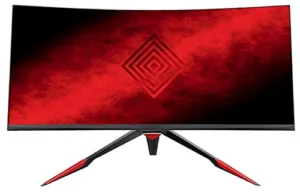A review of commercially available curved gaming monitors indicates that they typically do not achieve the same state of the art specifications that can be achieved in a similarly sized flat gaming monitor. JapanNext Co., Ltd. (Tokyo, Japan) has addressed this issue with the August 8th release of a new monitor offering, the model JN-35VCG200UWHD
JapanNext’s new curved gaming monitor.
The liquid crystal display included in the monitor uses so called Advanced Multi-domain Vertical Alignment (AMVA). This display technology was developed by AU Optronics and is characterized by utilizing more domains than in standard MVA displays. AMVA technology produces an image having good color uniformity, a high contrast ratio with a deep black color depth and good viewing angles. The power consumption in an AMVA display can be lower than competitive technologies because its’ high pixel transmittance allows for fewer LEDs in the backlight module. On the down side, the response times of AMVA based displays are typically somewhat slower than twisted nematic and in plane switching based liquid crystal displays. “AMVA displays can be considered a middle ground between the performance of low end, inexpensive twisted nematic displays and high end, in plane switching based displays.”
Specifications for the new JapanNext monitor include the following:
- Liquid crystal display: 35 inch AMVA
- Aspect ratio: 21:9
- Curvature: 1800 inch radius
- Native resolution: 2560 × 1080 (UWHD)
- Pixel pitch: 0.2382 mm
- Response time: 3 ms (grey to grey)
- 16.7 million colors
- Brightness: 300 cd/m²
- Contrast ratio: 2000:1
- Viewing angle: 178° horizontal, 178° vertical
- Power consumption: maximum: 60 W, typical: 40 W, idle: 0.5 W
An important feature of the monitor is the use of FreeSync dynamic refresh rate technology. FreeSync is the brand name of an adaptive synchronization technology for liquid crystal displays that support a dynamic refresh rate. It was developed by AMD and made available in 2014. The technology is free to use and should not degrade display performance.
Paraphrasing the description in Wikipedia, FreeSync technology is intended to reduce tearing and stuttering caused by misalignment of the monitor’s refresh rate with that of the frame rate of the video content. The synchronization mechanism keeps the video interface at the established pixel clock rate but dynamically adjusts the vertical blanking interval. The monitor continues to display the currently received image until a new frame is presented to the video card’s frame buffer, then transmission of the new frame starts immediately. This simple mechanism provides low monitor latency and a smooth, virtually stutter free viewing experience, with reduced implementation complexity for the timing controller and display panel interface. It also helps improve battery life by reducing the refresh rate of the panel when not receiving new images.
JapanNext has not reported the FreeSync range for the monitor, but it is likely to be between 30 and 200 Hz. This supports the low frame rate compensation feature and offers smooth play across different gaming modes.
A DisplayPort 1.2 and a HDMI 2.0 are included in the monitor and the use of one is needed to fully utilize of the 200 Hz refresh rate at 2560 × 1080. To maintain compatibility with legacy PCs, the JN-35VCG200UWHD also includes a DVI-D port.
Since gamers that purchase the JapanNext product may wish to use the monitor with more than one computer at the same time, the monitor can also support:
- PiP or Picture in Picture. In this mode, the screen is divided into two parts. The image produced by one source is displayed on the main screen while, at the same time, the image produced by the other source is displayed in an inset window.
- PbP or Picture by Picture. In this mode, the screen is divided in half displaying output from two different sources simultaneously on the left and right sides of the screen. (The PbP capability is available only at 60 Hz.)
Since the JN-35VCG200UWHD is targeted for gamers, its’ industrial design has been styled in a way that the company believes is attractive to this class of customer. The monitor comes in a chassis that has red inlays and is framed by a 1 cm bezel. The company claims that the bezel makes it easier to assemble a multi monitor system. As a separate matter, the monitor supports presets for three different game modes.
The JapanNext JN-35VCG200UWHD monitor will be available in Japan at a manufacturer’s SRP of $808. This puts the JapanNext monitor at a price significantly lower than the $1,185 listed on the Amazon web site for the AOC AGON AG352QCX. The AOC AGON AG352QCX is the nearest competitor to the JN-35VCG200UWHD. Note, however, that, at this time, the JapanNext web site lists the JN-35VCG200UWHD monitor as on sale at a price of $629. -Arthur Berman

